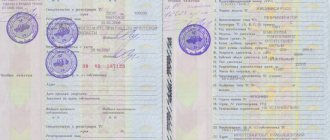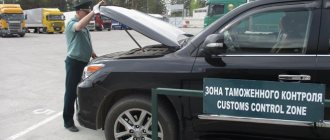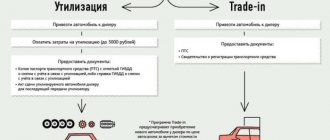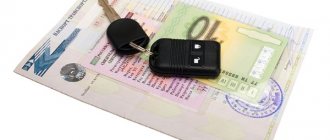What information does the PTS contain?
A vehicle passport is the main document of a car, containing detailed information about it. The passport is issued on a special strict reporting form and has a certain degree of protection in the form of special watermarks, holographic stickers and inscriptions.
The passport form is a sheet of A4 format, folded in half. The right side of the passport contains detailed information about the car. This part is filled out by a traffic police officer, vehicle manufacturer or customs service.
This part of the passport has 24 points with data:
- model, make of car;
- the country where the car was produced;
- car release date;
- body type;
- identification number (VIN code);
- name and details of the organization that prepared and issued the document.
The left half is divided into two parts. They contain information about all owners of the vehicle. The reverse side consists of four parts, also intended for entering data about the owners of the car. Thus, the maximum number of owners who can be entered on one form is 6.
You can see what a blank PTS form or a correctly executed document looks like in a photo on the Internet.
What does duplicate PTS mean?
A duplicate vehicle passport (PTS) is an official document that is issued by the State Traffic Safety Inspectorate indicating the reason for issuance and the details of the original.
A duplicate PTS is issued to the car owner in two cases. The first is when there is no free space to enter new information (the columns have run out).
The original document has 6 fields for filling in information about the owner of the car. At first glance, it seems that there are a lot of fields, and there are more than enough of them even to resell the car several times. However, this opinion is wrong.
Let's explain with an example. The first owner of the vehicle is the manufacturer, then the car is sent to the dealership for sale. And 2 fields have already been filled, although the iron horse did not even have time to reach the hands of the car enthusiast. There are also frequent cases when a car wanders from one salon to another, waiting for the time of operation. These are a couple more filled-in boxes.
Also, when changing the owner’s last name, first name or patronymic, this information is indicated in the PTS. Thus, the car can only be used by one person, and there will no longer be any free space in the vehicle passport.
The second case is the loss or theft of a document. This is another reason why vehicle owners contact the traffic police. In this situation, future buyers of used cars should be careful. In this article, Autocode will tell you how to prevent problems that can result from buying a car with a duplicate title.
What is the difference between an original PTS and a duplicate?
In certain situations, restoration or replacement of the registration certificate is required.
If the original is lost or damaged, as well as if the personal data of the car owner changes, a duplicate PTS is issued. This document is issued at the traffic police department upon presentation of a package of documents. The purpose of issuing a duplicate is to replace the original. This paper completely repeats the main content of the technical passport and has its own details. So what is the difference between a duplicate PTS and the original?
The main difference between this document and the original is the presence in the upper left part, in the “Special about. This paragraph also states the basis for issuing a copy and indicates that the registration certificate has been re-issued.
In what cases is a duplicate PTS issued?
The grounds for issuing it are few.
There are only a few reasons allowed for the re-issuance of PTS:
- loss of PTS;
- damage to a document;
- All lines on the PTS form are filled in, and there is no way to enter the new owner of the car.
Also, a duplicate PTS is issued to the car owner due to the need to make changes.
They are necessary to increase the relevance of information and concern only three points:
- Place of registration of the owner of the vehicle.
- Personal information of the car owner.
- Information about the vehicle.
These situations are not formal grounds for issuing a duplicate. But experienced motorists in such cases advise the owner to make changes to the current title.
Saddle up early
It is advisable to ask for the vehicle’s vin code to be sent to you via SMS before inspecting the car. And through some service you will get acquainted with the exact data of the car. These data should not differ in any way from the data in the PTS. Now some sellers also indicate the VIN code in the ad.
On the State Traffic Safety Inspectorate website you can view the history of registration actions, check for search warrants, restrictions on registration, and recently they have been keeping records of vehicle participation in road accidents. Use various online resources to check your car. Here you can read about how to check a car for collateral and credit.
Do not hesitate to be annoying and meticulous; if the seller has nothing to hide, then he will allow all checks to be carried out.
I'm waiting for you on the pages of my blog again! Ask questions, I will look into them with pleasure.
Share this post
- Related Posts
- Best time of year to buy a car
- Is it possible to refund VAT on a car purchase?
- We check the title before buying a car
- Electronic PTS when purchasing a new car
- Buying a car without money
- How a car dealership imposes extras on customers
The procedure for obtaining a duplicate PTS
You can receive a duplicate in 1 day. If additional checks are carried out, the registration period may increase to 30 days.
To re-receive a lost or replace a valid registration certificate, the following data is required:
- passport;
- documents confirming the purchase of the vehicle;
- certificate confirming ownership of the vehicle;
- explanatory note (if lost);
- MTPL insurance policy;
- receipt of payment of state duty.
After providing all the necessary information to the MREO, you need to go through the vehicle inspection procedure. If the registration certificate is lost, the inspector will inspect the car and sign the application. All documents are handed over to the traffic police officer.
What does the PTS look like and what information does it provide?
Forms for PTS are printed by Gosznak on special paper with watermarks. The document has a series and number.
The technical characteristics of the vehicle are indicated in the vehicle passport once and cannot be changed.
The document states:
- VIN - identification number;
- vehicle make and model;
- name (vehicle type);
- vehicle category;
- year of vehicle manufacture;
- model, engine number;
- chassis (frame) No.;
- body (cabin, trailer) No.;
- body color (cabin, trailer);
- engine power and volume;
- vehicle mass (with and without load), etc.
Information about car owners in the registration certificate is written on the back of the document. All records are kept sequentially. Each entry (if there is a change of owner) is certified by the signatures of the previous and new owners, and is also certified by the traffic police.
How to distinguish a fake from the original
Unscrupulous sellers, for the purpose of deception, use a fake vehicle passport.
Modern fakes are practically no different from the original. How can a simple car owner, using available means, distinguish a real document from a “fake” paper? To examine the document you will need an ordinary flashlight and a magnifying glass. What should you pay attention to?
- First of all, you need to pay attention to the originality of the document.
- If the car seller has a duplicate on hand, you need to find out why it was issued.
- The vehicle passport is issued on a blue form measuring 20x31, which is printed on special paper. It feels denser to the touch, differs significantly from a simple one and looks more like a banknote.
- The RUS watermarks and stars should be visible in the light of the document.
- The hologram must have clear boundaries.
- The signature “PTS” should be located above the hologram in the corner. You can see it in the upper left corner by tilting the document about 30 degrees and highlighting it with a flashlight.
Upon detailed inspection of the document with a magnifying glass, you can see the special inscription “vehicle passport”. It is located on the line of the inner fold and forms a dark unbroken stripe.
The main inscription: “Vehicle Passport” sticks out a little. This can be felt by palpation.
The date of production of the form is indicated in the left corner of the bottom of the form. If the form was produced much earlier than the PTS was issued, then this is a fake.
Methods for identifying fake PTS
Other people, in order to illegally sell a car, resort to such actions as falsifying documents.
In this case, the seller will provide a fake original PTS , so the buyer will have no doubts about the fairness of the transaction until the time when he is stopped by traffic police and informed that the car is stolen.
To avoid getting into such a situation, you need to be able to distinguish the original from the fake.
Checking with improvised means
Before you go on a deal, you should take two easily accessible tools from home:
- regular flashlight;
- magnifying glass with 10x magnification.
Having picked up the PTS, you should do the following:
- the form paper visually and tactilely must match other documents from the Gosznak organization;
- the hologram should not contain tangible transition boundaries;
- by pointing a magnifying glass at the hologram, you can see a car with “Russia” written on the windshield;
- tilting the document 30 degrees, under the sun or the light of a flashlight, the PTS should have the inscription “PTS”;
- the inscription “Vehicle Passport” must be voluminous, which can be felt when held with your fingers;
- on the last page of the document there is a rosette pattern, which, when the position of the PTS changes, changes color from green to gray;
- when the document is clear, the inscription B3 “RUS” and asterisks will be visible;
- There should be no blurring of graphs and inscriptions.
Special tools
If desired and possible, you can acquire more professional tools. They are sold in regular retail stores and at an affordable price, so to avoid fraudulent schemes, it is worth purchasing at least one of the following items:
- pocket microscope;
- ultraviolet flashlight;
- infrared detector.
Using a pocket microscope
With this device you can examine various small elements that are difficult to see with the naked eye. A pocket microscope will help you see the accuracy of the applied hologram, the number and series of the document. Protective fibers should be visible in the texture of the paper.
Using an ultraviolet flashlight
Under ultraviolet light, all government documents and banknotes will glow in three colors using security threads that are invisible in normal light.
What should you be wary of?
You need to be careful when buying a used car.
When checking the original passport or its copy before concluding a contract, you should also pay attention to these signs:
- too many previous car owners;
- car ownership periods are too short;
- remote registration region;
- the seller is in a hurry and nervous, rushing to conclude a deal as quickly as possible;
- undervalued car;
- The document is too neat, looks like it was reprinted.
If, when checking the document, at least one of the points was identified, there is no need to immediately refuse the purchase. It just takes more time to check the car owner's documents.
Buying a car with a duplicate title
Using a duplicate title instead of the original may be a sign of fraud if you are the buyer of the car. The most common situation is when the owner tries to sell a car that was purchased on credit and is still pledged to the bank. Since the car’s title is kept in the bank until its cost is fully paid, the fraudster contacts the traffic police and receives a duplicate of the allegedly lost document. After that, nothing stops him from selling the car.
Indirect signs of a fraudulent scheme that should make you wary are usually:
- transit numbers on the car;
- the period between purchase and sale is too short;
- the presence of several owners who changed over an implausibly short period (this is usually done to confuse the tracks and make it difficult to find the fraudster);
- reduced cost of an excellent car (10-15% lower than the market average);
- sale by proxy;
- a categorical demand from the seller to pay him the entire amount immediately.
If you have recorded at least one of these signs, do not rush to conclude a deal and give the seller your money. First, ask him to show the car's ownership document. The owner of a car that is pledged will not be able to show the purchase and sale agreement, since this paper is also in the bank along with the original PTS. However, if he agreed with a friend about a fictitious resale, and the title indicates two or three owners, then the existence of an agreement does not mean anything.








